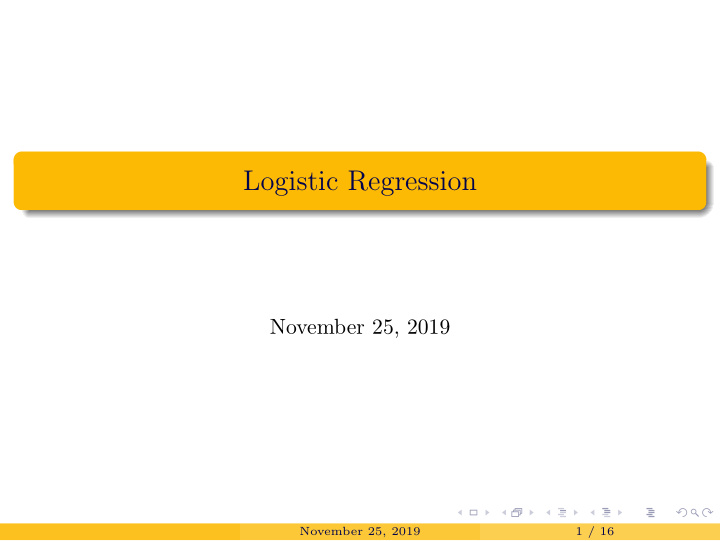



Logistic Regression November 25, 2019 November 25, 2019 1 / 16
Example Estimate Std. Error z value Pr( > | z | ) (Intercept) -2.7162 0.1551 -17.61 < 0.0001 job city:Chicago -0.4364 0.1141 -3.83 0.0001 years experience 0.0206 0.0102 2.02 0.0430 honors 0.7634 0.1852 4.12 < 0.0001 military -0.3443 0.2157 -1.60 0.1105 email address 0.2221 0.1130 1.97 0.0494 race:white 0.4429 0.1080 4.10 < 0.0001 sex:male -0.1959 0.1352 -1.45 0.1473 Write the logistic regression model for these data. Section 9.5 November 25, 2019 2 / 16
Example Use the logistic regression model to estimate the probability of receiving a callback for a job in Chicago where the candidate lists 14 years experience, no honors, no military experience, includes an email address, and has a first name that implies they are a White male. ...then calculate the probability of receiving a callback for a candidate who is the same on all characteristics but race. On average, how many jobs does each candidate need to apply to in order to receive a callback? Section 9.5 November 25, 2019 3 / 16
Resume Data This is a simplified version of the actual data used in the 2003 article. The full data produced the same basic conclusions. Because regression is about trends or averages, it is impossible (using this data) to point fingers at any particular employer or hiring managers. All we can say for sure is that the data shows a clear racial bias in job callbacks. Section 9.5 November 25, 2019 4 / 16
Logistic Regression Diagnostics There are two key conditions for the logistic regression model: 1 Each outcome y i is independent of the other outcomes. 2 Each predictor x i is linearly related to logit( p i ) if all other predictors are held constant. Note: the linear regression assumptions of constant variance and normally distributed residuals come from the normal model. In a logistic regression, we assume a binomial model. Section 9.5 November 25, 2019 5 / 16
Diagnostics for the Callback Rate Model: Independence Independence is satisfied because the resume characteristics were randomly assigned. Section 9.5 November 25, 2019 6 / 16
Diagnostics for the Callback Rate Model: Linearity It is difficult to check linearity without a fairly large dataset. Fortunately, the resume data has 4870 entries. Section 9.5 November 25, 2019 7 / 16
Diagnostics for the Callback Rate Model We want to assess the quality of the model. Ex: if we look at resumes that we modeled as having a 10% chance of getting a callback, do we find about 10% of them actually receive a callback? Section 9.5 November 25, 2019 8 / 16
Diagnostics for the Callback Rate Model We will start to think about this using a plot. Section 9.5 November 25, 2019 9 / 16
Diagnostics for the Callback Rate Model We will add to this plot as follows: 1 Bucket the data into groups based on predicted probabilities. 2 Compute the average predicted probability for each group. 3 Compute the observed probability for each group along with 95% confidence intervals. 4 Plot the observed probabilities (with the confidence intervals) against the average predicted probabilities for each group. Section 9.5 November 25, 2019 10 / 16
Diagnostics for the Callback Rate Model Section 9.5 November 25, 2019 11 / 16
Groups of Different Sizes Section 9.5 closes with an interesting probability problem. In the resume data, we found that individuals with names perceived to be from a Black person would have to send ≈ 50% more resumes in order to receive a callback. We want to consider other dimensions to this. Section 9.5 November 25, 2019 12 / 16
Example Consider a hypothetical company made up of 20% women and 80% men. Suppose the company has 20 , 000 employees. Whenever someone goes up for promotion, 5 of their colleagues are randomly chosen to provide feedback on their work. Now suppose that in this company, 10% of the people are prejudiced against the other sex. How often will people experience sex-based discrimination? Section 9.5 November 25, 2019 13 / 16
Groups of Different Sizes This is a very simplified example, but we’ve used probability to highlight something: Even when both groups are equally discriminatory, the smaller group will experience more discrimination. Increasing the imbalance in population size increases this discrepancy. There is a lot of nuance being left out here, but nonetheless this is an important probability property to be aware of. Section 9.5 November 25, 2019 14 / 16
Example: 9.17 Possum classification, Part II. A logistic regression model was proposed for classifying common brushtail possums into their two regions. The outcome variable took value 1 if the possum was from Victoria and 0 otherwise. Write out the form of the model. Also identify which of the variables are positively associated when controlling for other variables. Section 9.5 November 25, 2019 15 / 16
Example: 9.17 Possum classification, Part II. Suppose we see a brushtail possum at a zoo in the US, and a sign says the possum had been captured in the wild in Australia, but it doesn’t say which part of Australia. However, the sign does indicate that the possum is male, its skull is about 63 mm wide, its tail is 37 cm long, and its total length is 83 cm. What is the model’s computed probability that this possum is from Victoria? How confident are you in the model’s accuracy of this probability calculation? Section 9.5 November 25, 2019 16 / 16
Recommend
More recommend